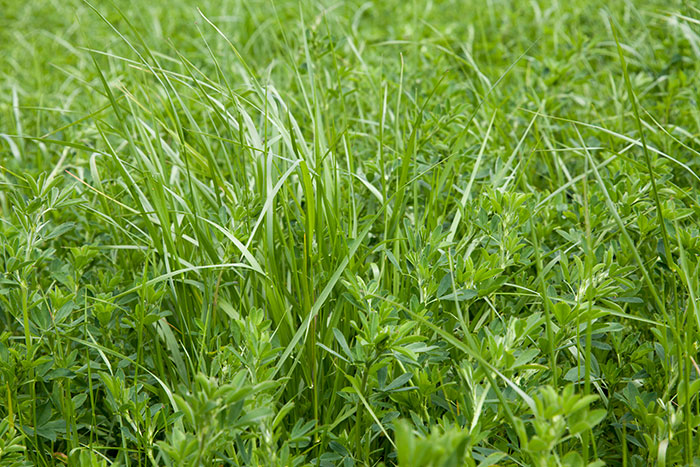Giving alfalfa a dance partner |
| By Mike Rankin, Managing Editor |
|
|
|
In many parts of the United States, alfalfa is cut three to five times per year for three to five years; then the stand begins to lose productivity and it is rotated to another crop. Research has shown that alfalfa yield decline hits about 25 percent during the fourth production year (fourth year after seeding). For operations that only want to intensively manage and feed pure alfalfa, three- to four-year rotations generally make good economic sense. There is, however, another road to take. “As an alfalfa stand begins to thin, consider interseeding grasses into it,” says Bruce Anderson, extension forage agronomist with the University of Nebraska. “Not only might you extend the useful life of your alfalfa field by several years, you will develop an excellent hay or grazing source for livestock,” he adds in a recent edition of Nebraska’s CropWatch newsletter. In his area, Anderson recommends seeding cool-season grasses into thinning alfalfa fields from mid-August to early September if soil moisture is adequate. It’s during this time that alfalfa growth is slowing, which provides less competition for the grass seedlings, and temperatures are beginning to moderate. Anderson says that if the alfalfa develops a full canopy later this fall, another cutting may be needed to allow sunlight to reach the developing grass seedlings. Orchardgrass is often the grass of choice when interseeding into alfalfa, but Anderson also suggests species such as novel endophyte tall fescue, meadow bromegrass, and festulolium. A mixture of grasses is also an option if the field will be used as pasture and you desire a diverse mix. Does it work? In my travels over the past couple of years, I have seen this practice put into place on two farms as a foundational strategy for extending the useful life of an alfalfa stand. Each farm, however, had very different end games. Clayton Geralds, a Munfordville, Ky., hay farmer, was highlighted in the January 2017 issue of Hay & Forage Grower. Geralds, along with his son Christopher, grow and harvest 720 acres of hay for the horse market. Over 500 of those acres are alfalfa-orchardgrass fields that began their life as pure alfalfa. Geralds no-tills 8 pounds of orchardgrass seed in his alfalfa fields after two or three years. This is usually done in September and extends the life of the fields by five to six years. He uses a late-maturing orchardgrass variety that better complements the maturity of alfalfa. “We start cutting our alfalfa-orchardgrass stands first, usually when we get a weather window after mid-April,” Geralds says. “Once the pure alfalfa stands reach late-bud stage, then we switch to them.” At Hedgeapple Farm in Buckeystown, Md., they finish 150 head of grass-fed beef per year. To get the desired 1.8 to 2.2 pounds of gain per day from weaning to finish, they rely heavily on alfalfa as a grazing and hay crop. Pure stands of alfalfa are established and grazed by the growing and finishing cattle. After two or three years, orchardgrass is interseeded to extend alfalfa stand life by three or four additional years. Those mixed stands are grazed but also harvested and wrapped as baleage for winter feeding. Dry bales are also made for maintaining mother cows during the nongrazing months. The alfalfa-based forage system perfected at Hedgeapple Farm has resulted in the ability to produce carcasses routinely grading Choice in 22 to 23 months for steers and 18 to 20 months for heifers.
Alfalfa may come to the dance alone, but there is opportunity to find it a dance partner in the form of a cool-season grass and keep fields producing for an extended time. |

